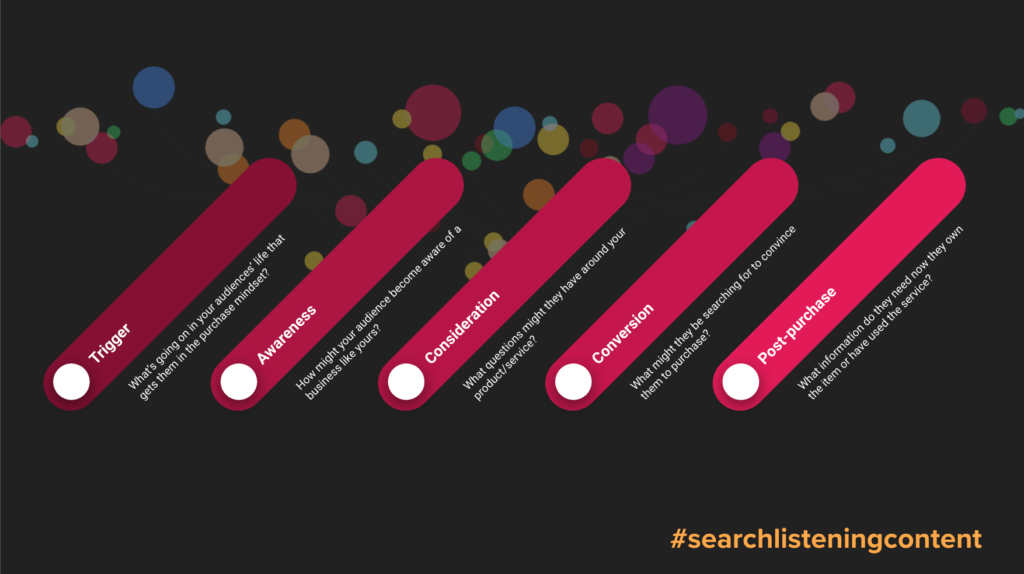
Every day we have hundreds of thousands of conversations with Google. We literally treat it like a trusted friend, asking it questions, like:
- Is it ok to wear white to a wedding?
- Why does my elbow hurt?
- How do you make pancakes?
I’ll bet you’ve spoken to Google in that human way at some point this past week, too. You might even have asked it something more personal to you; something you wouldn’t shout about on social media but are happy to type into Google’s anonymous white box, or to ask your phone or smart speaker. Something like ‘how do you ask a girl out?’ or ‘am I depressed?’.
That’s why ‘search listening’ is just as valuable a research method as ‘social listening’ or any other method when it comes to content marketing.
There’s so much soul-baring data available to explore and it tells us marketers so much about the people we’re trying to reach; their hopes, dreams, fears and needs. Understanding search behaviour is useful way beyond SEO – but, for me, not enough marketers know that.
Back in June, we were delighted to have Eric deLima Rubb from Brandwatch and Buzzsumo contributing our webinar: ‘How observing online behaviour can help you produce better content.’
Along with Search Listening’s Sophie Coley, Eric shared some brilliant tips and advice to help you become an expert in Search Listening for content:
What are the challenges facing content marketers?
Volume: as more and more people are creating content, the landscape becomes more saturated and it’s getting harder to make your content stand out. For example on WordPress alone, there are about 70 million new blogs created every month. So how do we break through and be the signal in that noise?
Sources: traditionally we used to think of content having a single home, like a blog or our Facebook page. But the way we define content, as well as the way we search and interact with it has evolved over time. We can now create content for our multiple social channels, we can become constant creators on YouTube, we can host our own Medium page…and not forgetting interactive spaces like Reddit and Quora too. There are now numerous places you could create content for.
ROI: how do we measure content? It all comes back to ROI. We all know how hard it is to approach a campaign or budgeting discussion and to lay out how we’re going to measure if it was successful. ROI is always a challenge, especially if you’re trying to plan out a content strategy in advance. How do you get buy in upfront by referencing how you think you’re going to measure its performance once it’s concluded?
Overcoming those challenges:
Make time to plan and research regularly, so that you’re not just adding to the huge volume of content being published, and so that you can be confident in hitting your objectives and KPIs.
Don’t limit yourself to keyword research – think about your audience and seek to understand, via whatever source (though AnswerThePublic is a great start point!):
o Their wants and needs (purchases, services, information, etc.) – traditional keyword research will definitely help you here
o Their attitudes, thoughts and feelings (fears, hopes, aspirations, trust, etc.)
Explore search statements starting with ‘I hate…’ or ‘I want to…’
Look out for publishers, personalities and influencers in ATP wheels – if they’re there, they’re potentially trusted by an audience
o Their behaviours (what they use, what they do, how and when they do it, etc.)
Buzzsumo is great here to understand what kinds of content people are sharing – and from which publishers
o Their sense of self (labels I give myself and others, what influences me, my demographics, etc.)
Think about the keywords you enter into AnswerThePublic. If you’re a ski holidays brand you might run a report on ‘skiing’ but you should also look at ‘skiers’. Similarly ‘reading’ can become ‘reader’ or ‘bookworm’ and if you’re interested in ‘recipes’, you might also want to explore ‘foodie’.
o Remember to look for trends in the results you see from AnswerThePublic – Sophie highlighted the example of ‘tofu’ and the ‘tofu to chicken ratio’ search on the wheel. A learning like this might inform a change to a whole suite of content (i.e. making sure all chicken recipes give an alternative quantity for someone who might want to make the recipe with tofu).
The difference between keyword research and audience research:
- Keyword research is tactical, literal and rooted in the ‘now’ (so you’ll look at volumes and specifics)
- Audience research is strategic, lateral and looks to the future (so you’ll look for themes, patterns and trends and think about how they might play out in the future)
Shaping content for the customer journey
- Customer journeys differ vastly according to the industry you’re in but a simple one we can use to illustrate our thinking is:
- Trigger – What’s going on in your audiences’ life that gets them in the purchase mindset?
Examples could be:
o They’ve just had a baby and are struggling to get them into a good sleeping pattern
o They’ve decided to quit their job
o They’ve had a bad experience with a supplier
o A family member has been diagnosed with an illness
TIP: Once you’ve understood the trigger, think about all the ways you could help that person
- Awareness – How might your audience become aware of a business like yours?
Examples could be:
o They’ve seen an influencer recommending the product
o They’ve seen a recommendation in a forum
o They’ve seen some advertising
TIP: Explore where that awareness is coming from. If it’s an influencer – what else is the influencer promoting? If it’s a forum – what else is being discussed there?
- Consideration – What questions might they have around your product/service?
Examples could be:
o They want to know which is better; comparing your product or a rival product
o They might be asking about specifics, e.g. ingredients, materials, processes, heritage,
TIP: Use AnswerThePublic and/or Buzzsumo’s Question Analyzer to find all the relevant questions!
- Conversion – What might they be searching for to convince them to purchase?
Examples could be:
o They want a discount because they’re a student/senior/healthcare worker/veteran/military personnel
o They want to see reviews from others
TIP: Explore reviews of your own product/service/organization and identify themes. What do people love? What do people hate?
- Post-Purchase – What information do they need now they own the item or have used the service?
Examples could be:
o A product might need a repair
o They might be wanting to hack the product somehow
o They might want to know their ownership rights
o They might want to know how you’ll invest/spend their money
TIP: Don’t stop exploring audiences once they become customers. In AnswerThePublic, think about ‘pre-purchase’ and ‘post-purchase’ searches (so ‘flights’ and then ‘my flight’, or ‘shoes’ and then ‘my shoes’). If you don’t work in a commercial organization then think about ‘abstract’ and ‘possessive’ (so ‘mental health’ and then ‘my mental health’ or ‘families’ and then ‘my family’).
We’ve got a worksheet if you want to explore the customer journey in more depth, which can be found here, as well as a free handy infographic which will help you to get the best from AnswerThePublic here.
You can also head over to our YouTube channel here, where you’ll find lots of AnswerThePublic ‘How to’ videos and webinar recordings.







